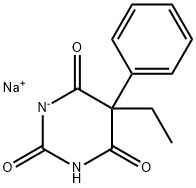Solution S is clear (2.2.1) and not more intensely coloured than reference solution Y7 (2.2.2, Method II).
Phenobarbital sodium salt has been used:
- to anesthetize mice for inducing ischemia-reperfusion injury
- as a positive control for the activation of constitutive androstane receptor (CAR)
- in bioluminescent yeast bioreporters (BLYAS) assay
Anticonvulsant; sedative-hypnotic.
ChEBI: A barbiturate that is the sodium salt of phenobarbital (barbituric acid substituted at C-5 by ethyl and phenyl groups).
Luminal Sodium (Sterling Winthrop).
Odorless white crystalline powder. Aqueous solutions are alkaline to litmus and phenolphthalein (pH approximately 9.3). Bitter taste. A narcotic.
Hygroscopic. May be sensitive to prolonged exposure to air. Water soluble. Aqueous solutions are unstable, but may be kept at or below 50°F for a few days.
Phenobarbital sodium can react with strong oxidizing agents. Incompatible with ammonium salts and chloral hydrate. Also incompatible with acids and acidic substances .
Flash point data for Phenobarbital sodium are not available; however, Phenobarbital sodium is probably combustible.
Phenobarbital, a substituted barbituric acid is an antileptic drug and is not easily eliminated from circulation. It hyperpolarizes the synaptic neuronal membranes by favoring the activation of neuronal postsynaptic GABAA?receptors by γ aminobutyric acid (GABA). Phenobarbital is also effective in treating neonatal seizures and status epilepticus.
Confirmed carcinogen with experimental carcinogenic, neoplastigenic, tumorigenic, and teratogenic data. Poison by ingestion, intravenous, intraperitoneal, intraduodenal, and subcutaneous routes. Human systemic effects by ingestion: nausea or vomiting and coma. Experimental reproductive effects. Mutation data reported. Used to treat epilepsy, as a hypnotic and sedative. When heated to decomposition it emits toxic fumes of NOx and NazO. See also BARBITURATES
